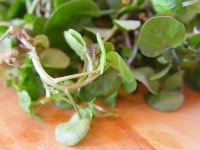 Water Cress is a peppery herb that is commonly used as a salad ingredient. Though sometimes deployed as the main ingredient, I prefer it in a supporting role - a cress, potato, and egg salad they do at Chez Panisse comes to mind. I picked up this bunch from the County Line Harvest folks.
Water Cress is a peppery herb that is commonly used as a salad ingredient. Though sometimes deployed as the main ingredient, I prefer it in a supporting role - a cress, potato, and egg salad they do at Chez Panisse comes to mind. I picked up this bunch from the County Line Harvest folks.According to Texas A&M Plant Answers, there are several varieties of cress:
...such as Garden Cress or Pepper-grass (Lepidium sativum), Upland or Winter cress (Barbarea vernapraecox) , Bitter-cress (Cardamine pratensis), Indian-cress (another name for nasturtium) or Tropaeolum majus, Penny cress or species of Thlaspi, rock-cress or species of Arabis, Stone-cress or genus Aethionema and Wart-cress or species of Coronopus.Incidentally that Texas A&M page manages to sneak in terribly specific generalizations about the culinary practices of people who live on the east coast, and also "Chinese" [sic]. Which is enough to make me want to question their curiously prosaic description of cress growing conditions:
Water-cress is a hardy, perennial, European herb (Nasturtium officinale) which grows naturally in wet soil along and in spring brooks, dithces and pond margins and is cultivated under such condition for use as a garnish and a piquant salad.

Preparing cress for use in salads generally requires removing the leaves from the stems. As the photos may suggest, when cooking for more than a handful of people, this can be both tedious and relatively expensive. Consequently, arugula tends to be the weapon of choice when peppery greens are called for here at consumptive HQ.
No comments:
Post a Comment